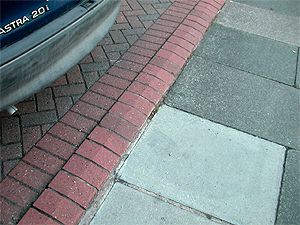tony could you explain to me why i see so many drives with tapered block edgings to the beginning of the drive, off the public pavement, i have done about 6 drives here in Walsall, west mids and i always use a standard pavior bedded on a concrete footing for the simple reason that when driving onto the drive from the road you get a smooth ride in and not like these other drives where you will get a certain for want of another word "bump", this has intrigued me, most of the drives ive seen with this doesnt seem to have any apparent and obvious reason to have it. is it because the contactor dosent have to excavate as deep as he is coming up higher using these tapered bricks.
look forward to your answr mate.
o yeah and just to warn ya. i have a few ground working mates and ive asked them all to think of a question so as to catch you out,(i doubt we will though)
Tapered edging to drive
-
84-1093879891
-
bobinalongnicly
- Posts: 18
- Joined: Sun Nov 30, 2003 9:39 pm
-
84-1093879891
In some cases it is, indeed, done to reduce the amount of excavation, but at the rise is only 25mm, there's not a great deal to be saved.
The most usual reason given for its use is that it prevents surface water from the public footpath washing back onto the private driveway, although the same effect can be achieved using a soldier course laid to an angle of, say 10 degrees.
Some clients (and some contractors) like it as it looks 'pretty' (allegedly) and gives the threshold some definition, although I like a Dutch Lap pattern if a fancy threshold is required for whatever reason. And then, some clients like the 'bump' effect, as it lets them know when both sets of wheels are safely on the driveway.
The key thing to remember when working in the driveway sector of the paving industry is that there's no accounting for taste and whoever pays the piper calls the tune. :)
In yet another of the half-finished pages lurking on my hard drive, I have a selection of alternative thresholds that have been used on driveways up and down the country. With a bit of luck and afollowing wind, I might get around to finishing it and getting it upoaded over the winter. :)
The most usual reason given for its use is that it prevents surface water from the public footpath washing back onto the private driveway, although the same effect can be achieved using a soldier course laid to an angle of, say 10 degrees.
Some clients (and some contractors) like it as it looks 'pretty' (allegedly) and gives the threshold some definition, although I like a Dutch Lap pattern if a fancy threshold is required for whatever reason. And then, some clients like the 'bump' effect, as it lets them know when both sets of wheels are safely on the driveway.
The key thing to remember when working in the driveway sector of the paving industry is that there's no accounting for taste and whoever pays the piper calls the tune. :)
In yet another of the half-finished pages lurking on my hard drive, I have a selection of alternative thresholds that have been used on driveways up and down the country. With a bit of luck and afollowing wind, I might get around to finishing it and getting it upoaded over the winter. :)
-
danensis
- Posts: 335
- Joined: Mon Aug 11, 2003 4:24 pm
- Location: Derbyshire
- Contact:
-
84-1093879891
